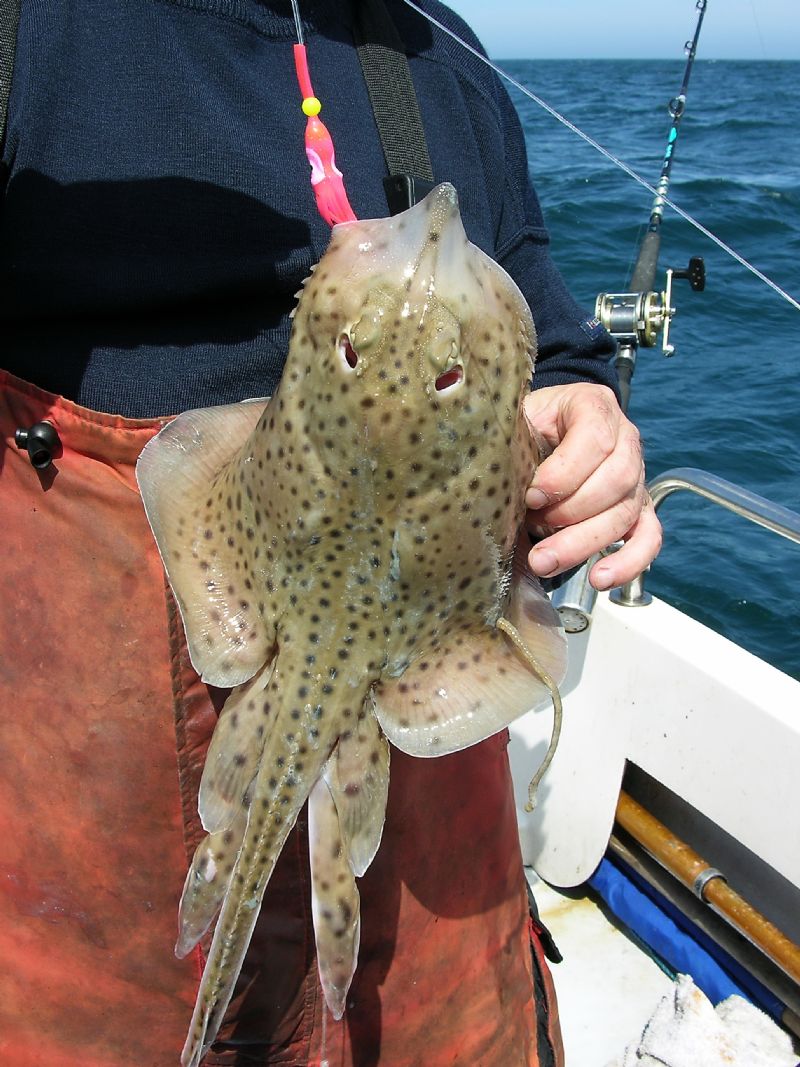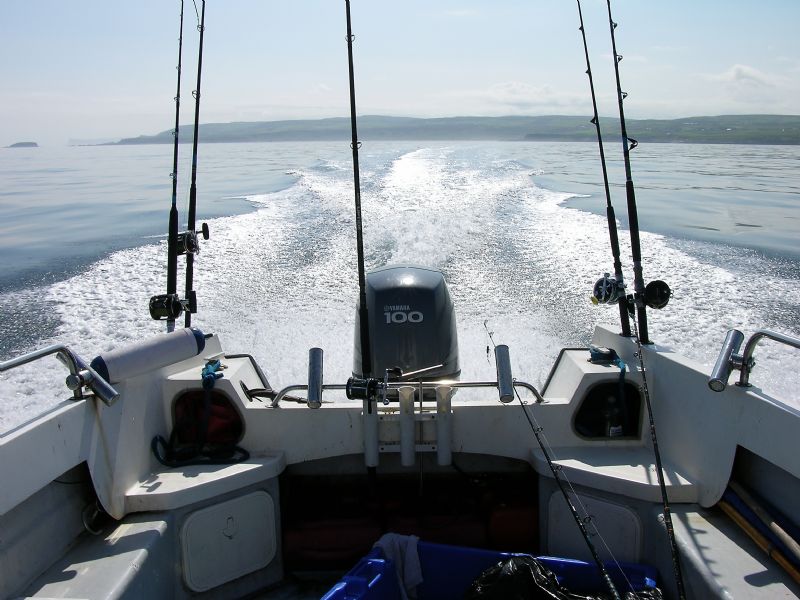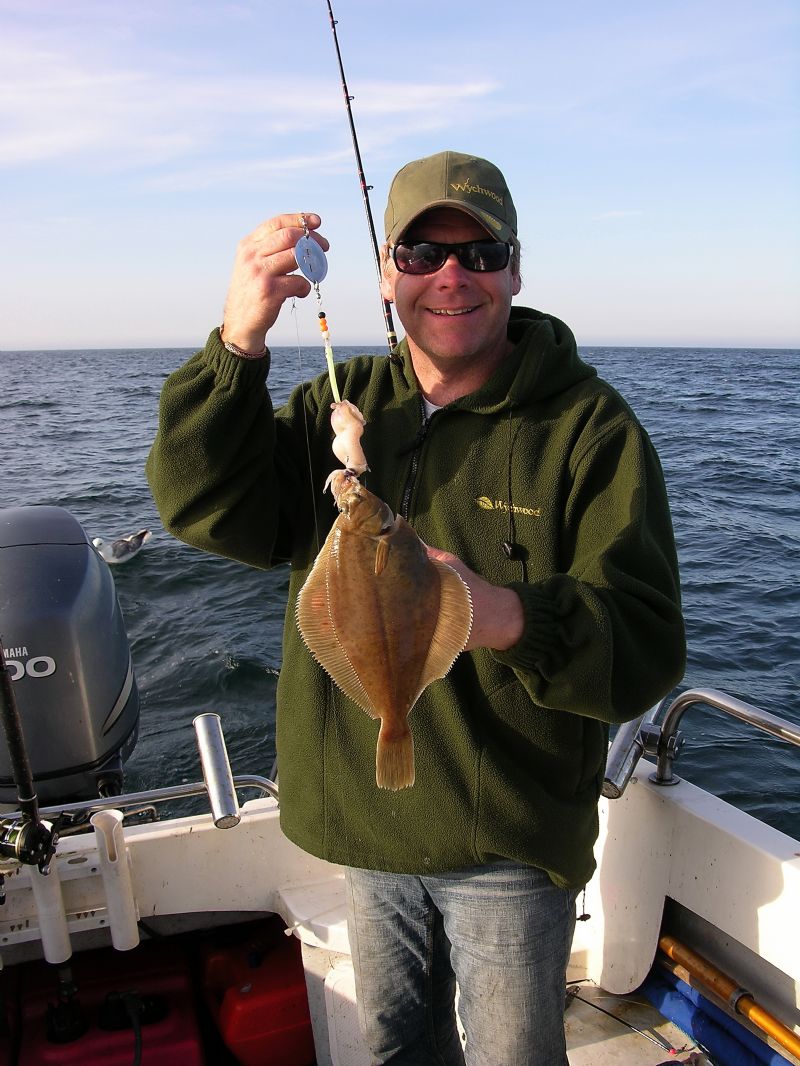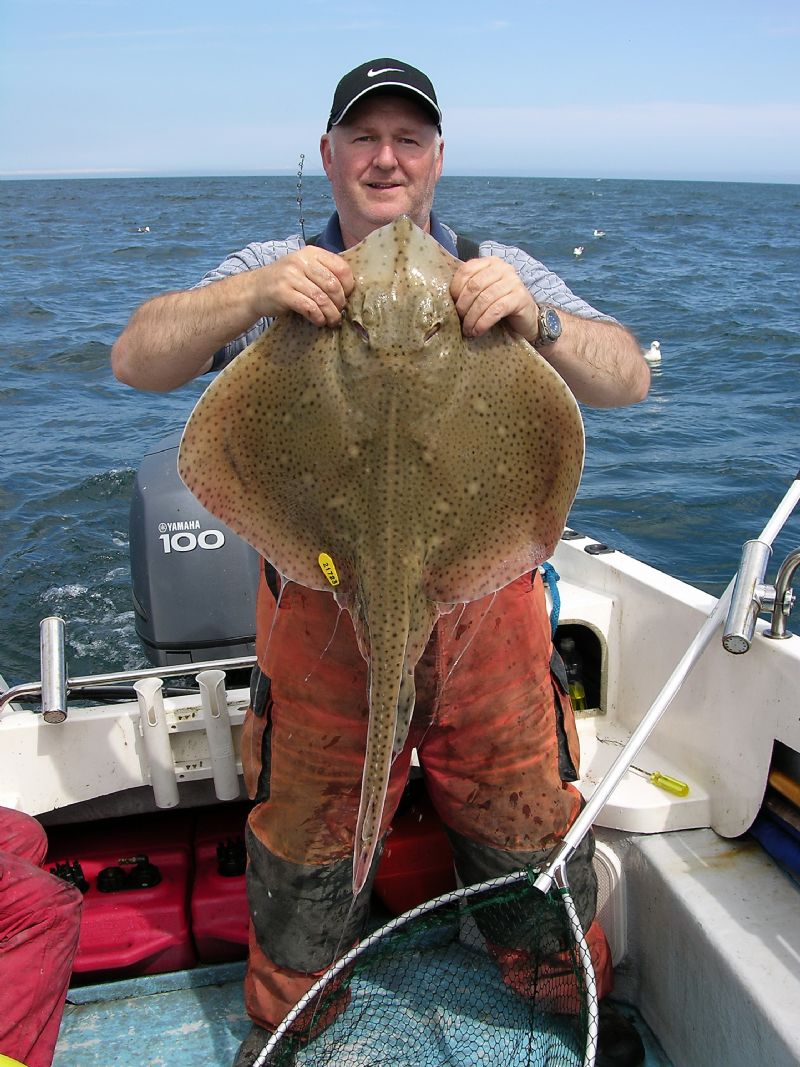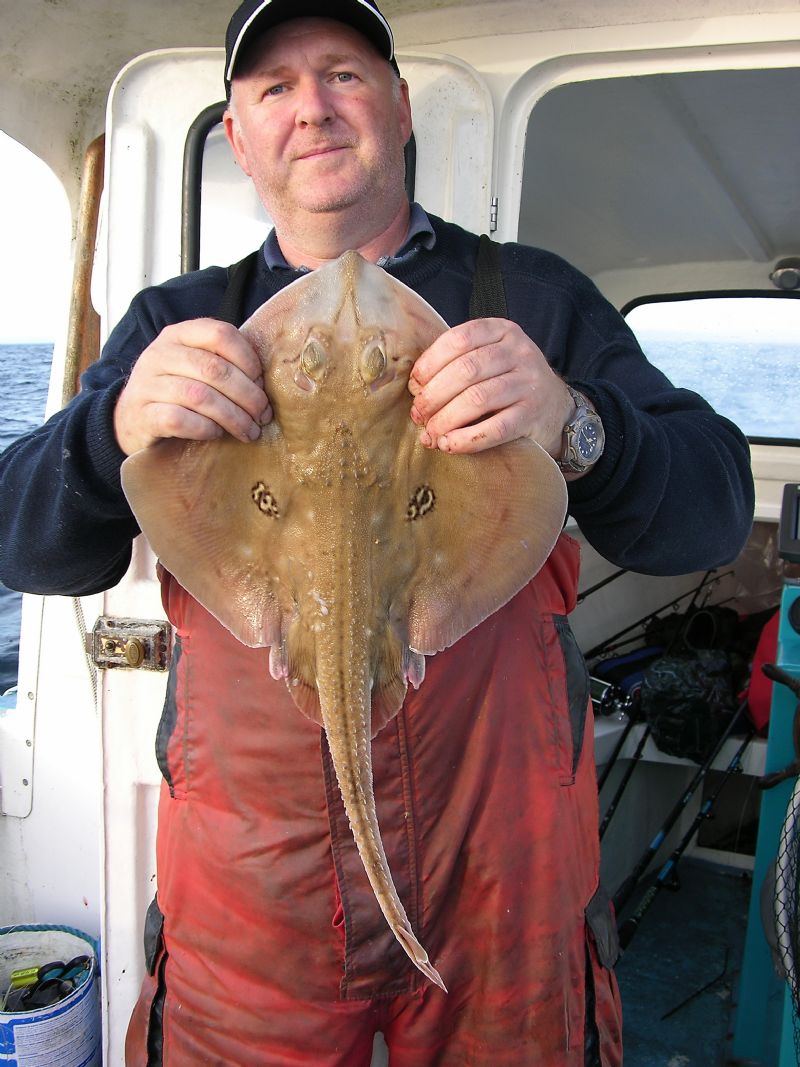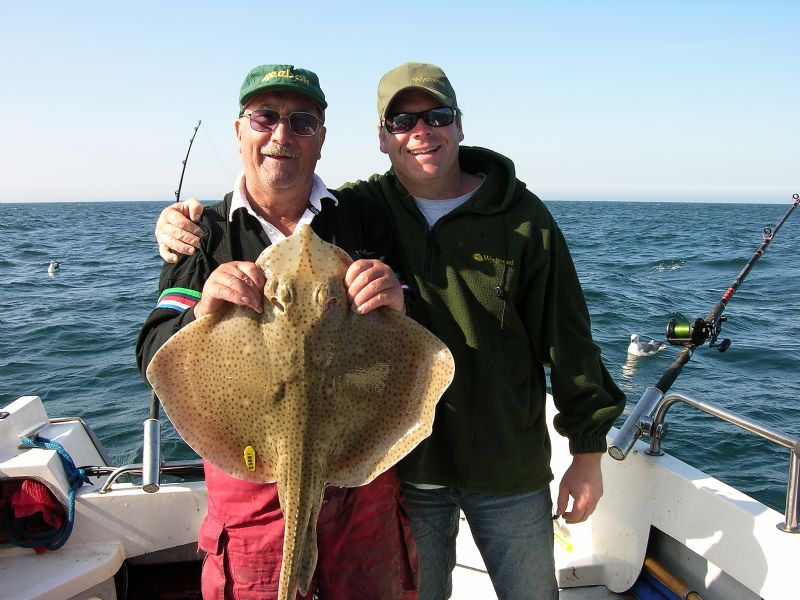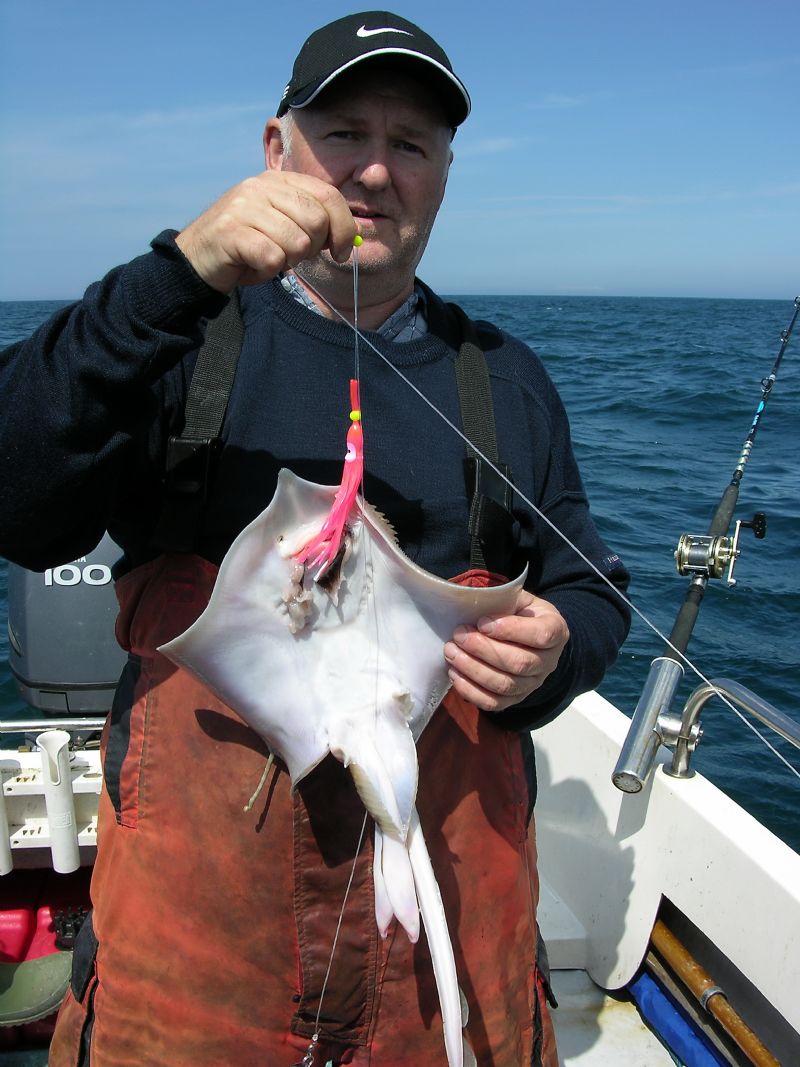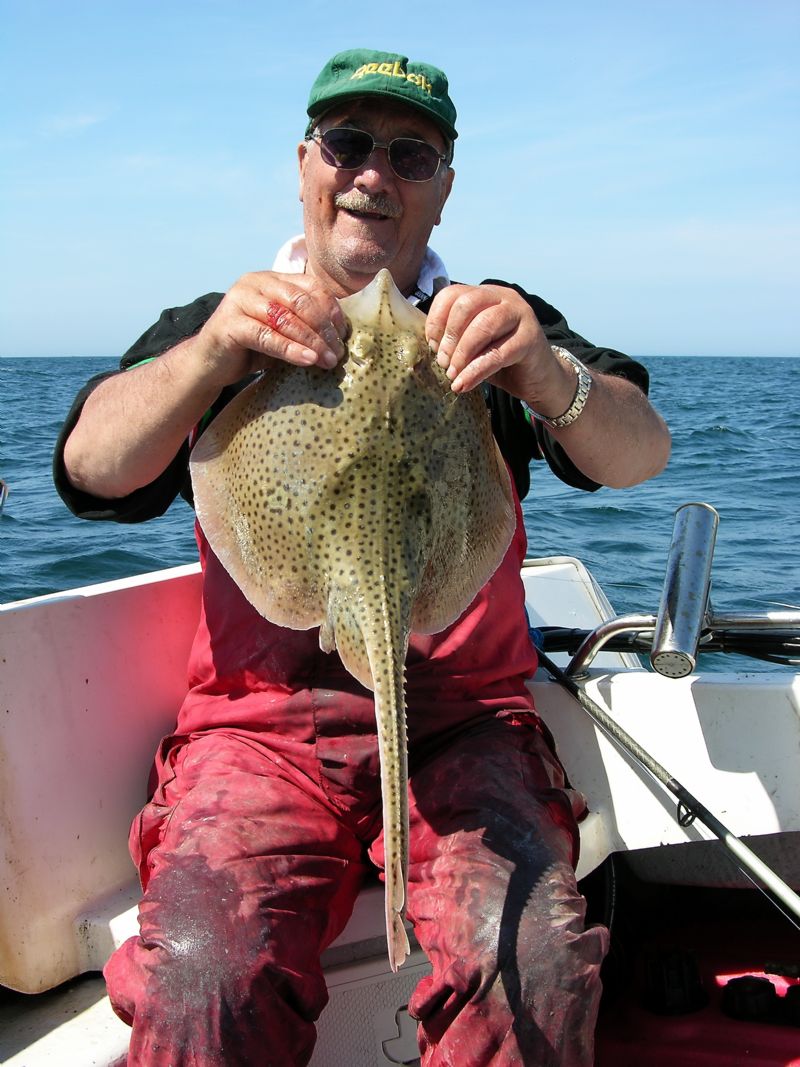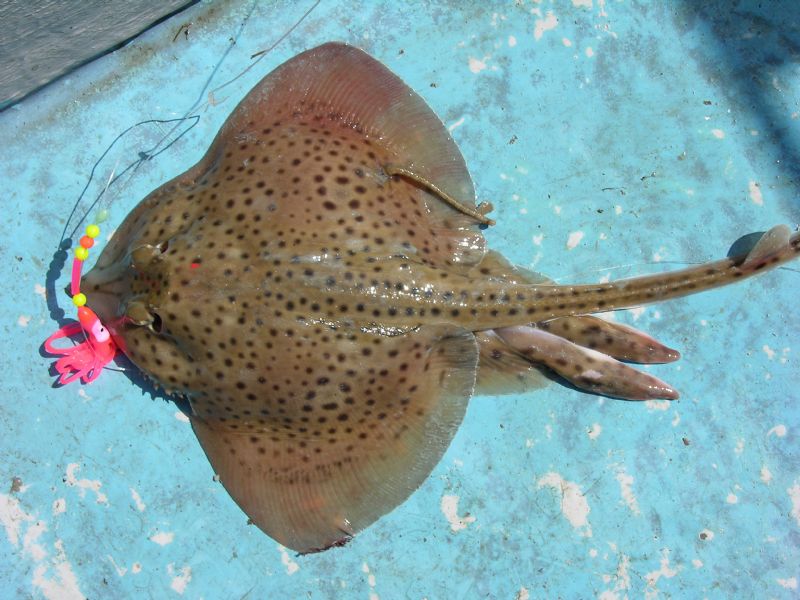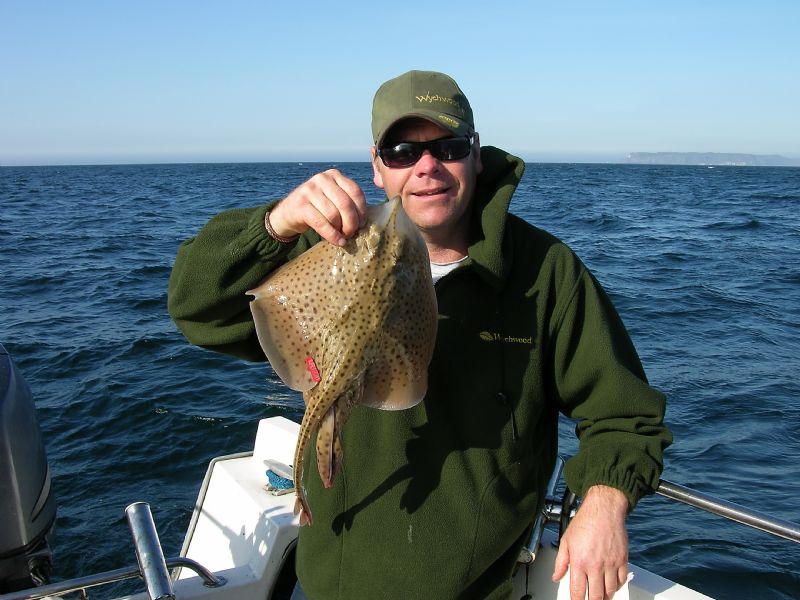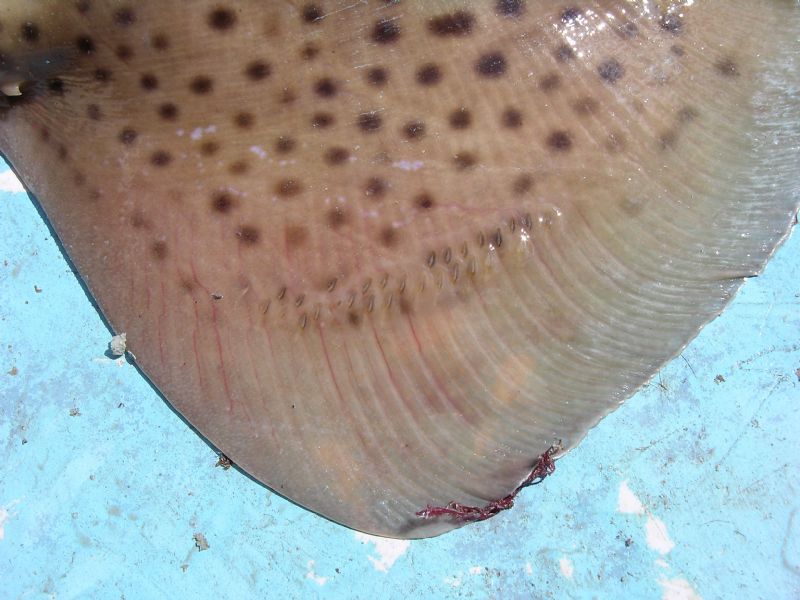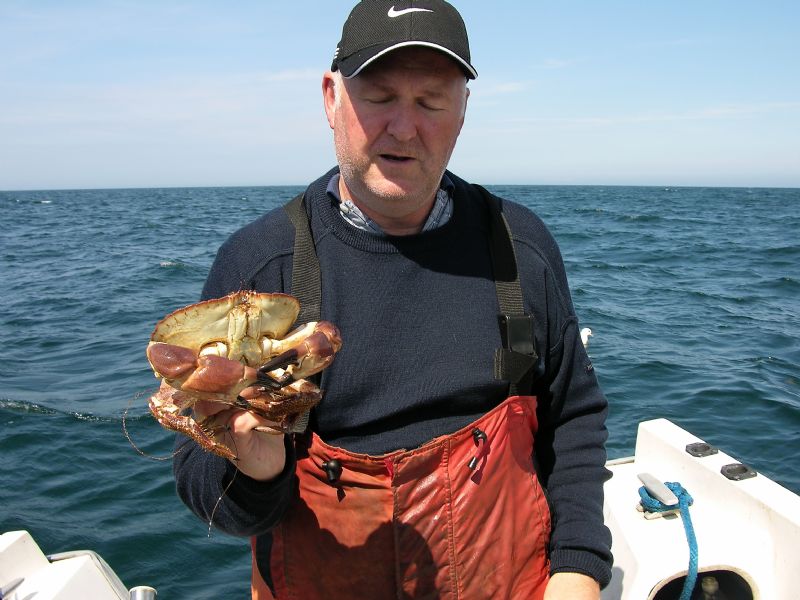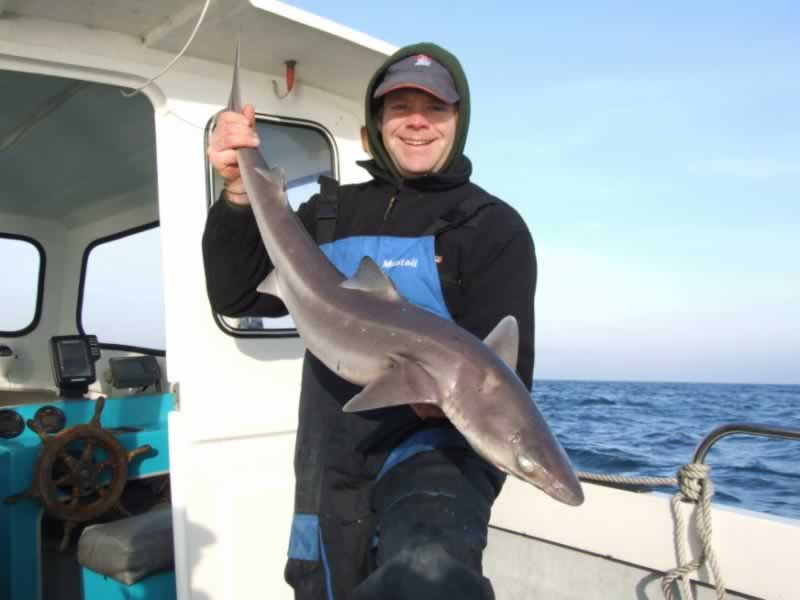Species hunt part 10 Homelyn Ray
Homelyn Ray also known as Spotted Ray
Fact file
Name Homelyn Ray
Latin name Raja montagui
Irish record 8.28 lbs taken on 28.09.1983 at Cork Harbour by Edmund Cull
Specimen weight 5 lbs
The trip
After last months adventure in pursuit of Cuckoo Ray, I decided this month, to remain on the ray theme. To explain, whilst searching out Cuckoos on my last trip, I discovered some extremely interesting underwater features that simply had to hold more than one species. I could not resist a return visit to further investigate these possibilities. One of these features lay some distance off-shore, and required favourable weather and tides, whereas the other series of sand-banks were close to shore in shallow water, and could be safely targeted should weather conditions become un-settled.
My target species this month is the Homelyn Ray, also known as the Spotted Ray. It enjoys the same haunts as the Cuckoo Ray, and to be honest, I was surprised it did not make an appearance on my previous trip. That said, the poor weather conditions on that day left little time to suitably explore the area. I was determined to rectify this, and with light southerlies forecast, I decided to make this trip a weekend affair. Angling pals, George and Andy would join me on Saturday morning, but due to work commitments, Big Phil couldn’t arrive until Saturday night. Des Young, Andy Jones and Dave Craig would meet us at the harbour Sunday morning.
Flat calm, if only all days at sea were like this!
My arrival at the harbour was met with glass-like sea conditions, from the shoreline to the horizon, which is every boat anglers dream. I thrive on days such as this, and desire to be nowhere else on earth. It’s the rough days of wind and rain that leave me longing for solid ground, tucked up under a brolly fishing for Bream or Tench! Once launched, and with such a calm day, the temptation is to head for the horizon in search of huge Pollack and Ling over offshore reefs, but the game plan was to try out previously noted marks and I decided to stick with that.
George and Andy were already out there, dropping glittering traces amongst dense Mackerel shoals. I was soon alongside, eagerly filling an ice packed cooler box with fresh bait supplies for the day. On a hot day such as this, it is vitally important to look after fresh Mackerel. They will quickly deteriorate; and dry, wrinkly Mackerel are only fit for the “chum” bag! With enough Mackerel to last a full angling session, it was make your mind up time. The obvious choice was the offshore mark. A quick check on the chart plotter showed where I had taken note of the potential hot spot, and I was on my way.
George and Andy decided to try an interesting underwater gully nearby, and I headed for my mark. I was on my own today, but on a positive note, I had enough space to use two rods with different methods to thoroughly investigate the mark for all manner of species. The underwater bank dramatically loomed up on the sounder, and I could hardly wait to drop a bait down. As always when anchoring, I prefer a drift over the mark first. This gives me a good idea of where to anchor for the best, making allowances for tidal strength and wind direction. It also gives me time to sort out the anchor, making sure the safety trip is secure, and the rope is neither knotted or tangled. It is much less hassle to get it right first time.
All went according to plan, and with the anchor set fast into the underwater bank, the GPS reading rapidly dropped from 0.9 to 0.0 knots, showing that the boat wasn’t moving an inch. First rod over was a two-hook, running ledger, baited with a Squid-Mackerel cocktail. As I set up the second rod, the first one bounced and buckled, and I lifted into an obviously large and powerful fish. A few seconds later it was gone, rig and all, leaving me wondering if my ray bait had attracted a Tope or stray Conger. Unfortunately, I will never know, and it’s now filed into the memory banks along with countless other lost monsters!
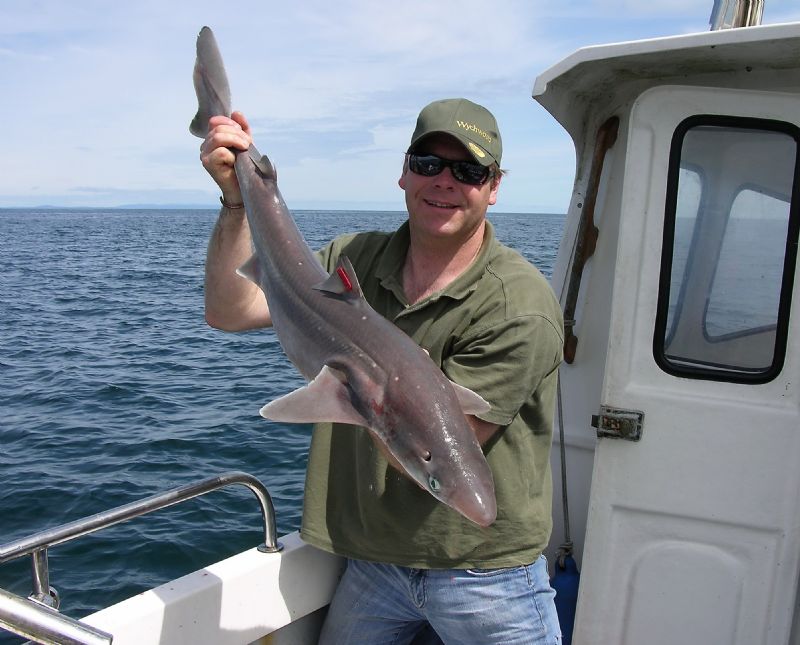
Just one of dozens of Spurs that showed over this interesting mark
After that rather interesting start, I settled into “normal” angling, two rods in the rests, and sitting back in the sunshine, waiting for the rods to nod. It wasn’t long before the ever-present “doggies” showed up, sometimes a nuisance fish I know, but better than nothing. Then, as the dogs faded, a proper bite, with positive thumps on the rod tip. This was no ray, and my suspicions were confirmed when a double figure Spur dog broke the surface. Looking to my other rod, I was alarmed to see this bent double, so the Spur was quickly unhooked at the side of the boat just in time to slacken the clutch a little and lift into another good fish. Three spurs this time, all around double figures. There were too many below to fish two rods, as the voracious pack immediately “snaffled” any bait down there, so with one rod only, it was time to roll up the sleeves for some serious “Spur bashing”.
Continuing through the slack tide, and some way into the flood, the tidal strength eventually increased to the point that either the Spurs had gone off the feed, or my baits were not being presented quite right. I drew the line at moving up to three pounds of lead in deep water; this was, after all, a pleasure trip. I had lost count of how many Spurs were brought to the surface, but three of the larger fish weighed were mid-doubles and well over the specimen barrier of twelve pounds. No rays on this occasion, but a very enjoyable session all the same. It was time to “up” anchor and away, but a mental note was made to try this mark again. If the Spurs move on, there would be a chance to target other species here, in the future, and maybe that larger fish that broke me!
A fine Dab taken on "ray gear"
Decision time again, and with calm seas, I was reluctant to move inshore. That inshore mark could wait until Sunday morning when the rest of the lads arrive. A call to George and Andy informed me that they had been pestered with Dogfish, small Whiting and Gurnards; the gully had proved relatively fruitless on this occasion. Another deep-water bank three miles to the east had thrown up Blondes, Cuckoos and two lost Skate on a previous trip, so perhaps this was worth another look. Fifteen minutes later, I was anchored in the fast part of the flood tide, eating sandwiches and drinking coffee, whilst waiting for the current to ease before dropping over a ray bait on the lighter rod, and a Skate bait on the 80lb class gear.
Eventually, this produced numerous dogs and one lost Skate, which was probably a godsend as I was on my own and starting to feel the tiring effects of the previous, deep-water Spur dog session! Unfortunately, I realise I’m not getting any younger! The lads had already gone back to harbour for the day, and it was time to follow suit. Lifting the anchor, the eyelet on the front must have snapped, and I managed to retrieve all but the anchor itself. It wasn’t the cost of a lost anchor that bothered me, but the necessary change in plans for Sunday, as I did not have a replacement. No option but to return to harbour and try to scrounge one from somewhere.
Back on dry land, the barbecues were on the go, along with a few refreshing beers and conversations on how the day had gone. The production line of burgers and sausages, alcohol and banter led us all too quickly into the early hours, and well past bedtime. The deep sleep was only interrupted by the large group of campers behind us, playing rave music until 5am! By morning, and with only two hours sleep, I realised that I am definitely getting too old for this!
Having sent a distress text to Davy the previous evening, he turned up with an anchor borrowed from Sean McKay, the top charter skipper on the Antrim Coast. Many thanks Sean, but unfortunately, this was big enough to hold back the Belfast ferry and had to be left in the back of the jeep! Nothing for it but to spend the day drifting, the old fashioned way. As it transpired, and not for the first time in history, the forecast was completely wrong, and the sea state looked quite daunting. I’m glad I did the offshore bit the previous day while I had the chance! Dave, Des and I ventured out and over the Mackerel shoals, for a cooler box of fresh bait, and limped along the waves and troughs of the horrible, following tide, to the range of inshore sandbanks that hopefully held the target species I had failed to find the previous day.
Dave wasn’t happy, as he wanted in amongst the Spurs I had found, but there was no way we could fish that mark without a suitable anchor. Besides, I insisted, it was time to find a “spotty ray” for the magazine. The first drift produced Dogs and Dabs, and there were plenty of them. Baits had to be made larger to put these “nuisance” fish off, and so hook sizes were moved up a notch, and the Mackerel strips were increased to full fillets, and Mackerel-Squid cocktails. Dave was first in with a decent fish, obviously too large to be a delicate little Homelyn. We weren’t surprised to see a respectable, double figure Blonde slip into the landing net.
A Cuckoo Ray and a Blonde! Still looking for the Spotted Ray!
Dessy was next as he struggled to prise another Blonde off the sea-bed. This continued on each successive drift, as I used the plotter to work along the bank, but all we could find were Blondes. This is no complaint, as Blonde Rays are great fun on light tackle, but I was beginning to feel the pressure that just maybe, my target species would elude us on this occasion. Dave lifted into a “ray” bite, and suggested that he may have cracked it this time, only to see a decent Cuckoo come up from the depths. My turn this time, and it looked hopeful, until yet another small Blonde broke the surface. Perfect size but too many spots! Further along the bank, Dave lifted into another small ray, and as we held our breath, staring into the depths, bingo!
Nice Ray Dessy, but too many spots!
The one we had all been looking for. A perfect little male Homelyn ray to pose for the camera. As is usually the case when angling, you wait all day then three appear at once! Des soon landed a perfectly formed female “spotty” followed closely by the skipper with a male, which had a bite out of its left wing. It wasn’t me that bit it, honest! This section of the bank must have been slightly different to suit the Homelyns. The drifts continued, and with the changing tidal direction, we lost and found fish throughout the session. They seemed to move and feed around the bank just as you would expect. At one stage we drifted onto a rougher patch and picked up a few Bull Huss, but that’s been earmarked for another time and another story. George and Andy struggled on an outer bank on this occasion, catching Dogs and Whiting but the four pounds of lead required to hold baits on the sea bed were simply too much. Big Phil and Andy Jones ventured into a small sheltered bay in search of Plaice and Dabs, with great success, landing a bonus seventeen-pound Blonde Ray on light tackle in fifteen feet of water to round off the day. All in all, a memorable and pleasurable weekend in search of a small, delicate little ray species, with a few bonus fish thrown in along the way.
Dessy (left) and Davy, both with the target species
Interesting facts
Homelyn Ray are found in the Eastern Atlantic, from the Shetlands, the southern North Sea and the western Baltic to Mauritania, including the western part of the Mediterranean, to Tunisia and western Greece. They are found in shelf waters up to 100 metres deep, with a depth range of 30-120 meters, but usually on the uppermost part of a slope. They feed mainly on crustaceans, which is curious, as they readily accept fish baits. Egg cases are oblong with stiff, pointed horns at the corners and are laid over sand or mud seabeds. The capsules are 5.3-7.8 cms long and 3-5 cms wide. An adult female will lay 24-60 eggs per year.
Typically, this Spotted Ray has a harmless leach-like parasite on its wing
Bait
As with most ray species, fresh Mackerel is the prime choice. Whole Calamari Squid or a combination of the two can be extremely successful, as was the case on this occasion. Sand eel can work well. Occasionally, Homelyns are taken on Ragworm-Mackerel cocktails from the shore.
Tackle
When targeting rays, several points must be considered, as mentioned in previous ray articles. Depth and tidal flow will dictate the choice of rod and reel. On the Saturday session, I used 30lb class gear to cope with the deep water and strong tides. The Sunday session over shallow sandbanks close to shore allowed the use of 12 lb class rod, 7000 size reel and eight ounces of lead. Small rays will not put any pressure on light, balanced gear but there is always the chance that a larger fish will pick up your bait, so the decision will rest upon how likely it will be that larger fish are present, or if you are prepared to lose that fish of a lifetime should it come along! This comes down to experience of an area, personal choice and a large “dollop” of luck. One or two-hook running ledgers are the business for rays. The hook length should be approximately eight to twenty feet, made up of at least fifty pounds b/s nylon. Hooks between 4/0 and 6/0, and add some attractors such as sonar spoons etc of your choice if you feel that helps.
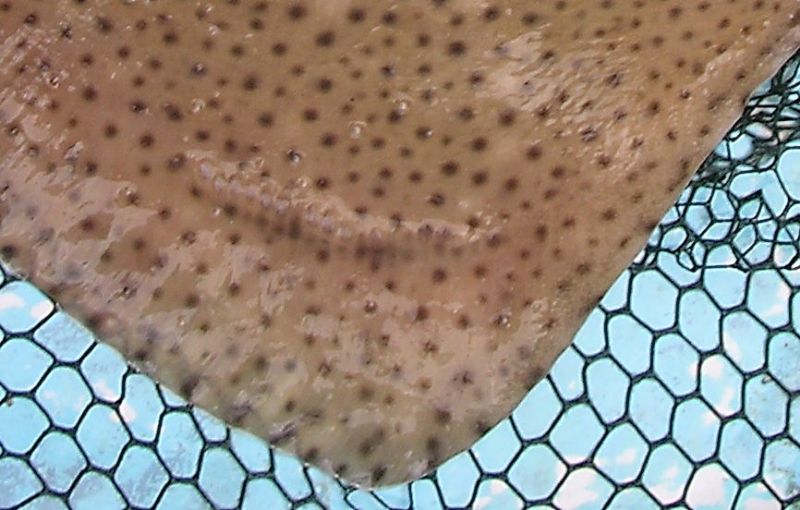
Comparison- Spotted Ray wing on the left, Blonde Ray wing on the right (spots extend to tip)
Tactics
Either act on information from the angling grapevine, as many do, the local Internet angling forums buzz with this kind of stuff all the time, or simply study the charts and go and look for your self. Personally, I find the latter much more rewarding. Invest in a chart plotter, as they are not very expensive these days. This will allow you to see the make up of the seabed, and work your boat along it in a methodical pattern. Many different rays will inhabit the same sand banks, but some species will lie deeper or shallower than others. As you work along the area, this will become apparent.




